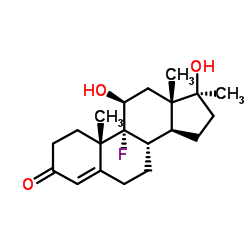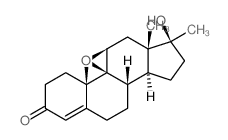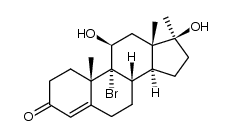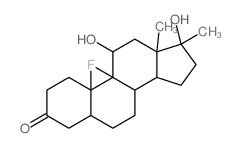76-43-7
| Name | Fluoxymesterone |
|---|---|
| Synonyms |
11b,17b-Dihydroxy-9a-fluoro-17a-methyl-4-androsten-3-one
(8S,9R,10S,11S,13S,14S,17S)-9-fluoro-11,17-dihydroxy-10,13,17-trimethyl-1,2,6,7,8,11,12,14,15,16-decahydrocyclopenta[a]phenanthren-3-one 9a-Fluoro-11b-hydroxy-17a-methyltestosterone MFCD00010480 9α-Fluoro-11β-hydroxy-17-methyltestosterone (8S,9R,10S,11S,13S,14S,17S)-9-fluoro-11,17-dihydroxy-10,13,17-trimethyl-1,2,6,7,8,9,10,11,12,13,14,15,16,17-tetradecahydro-3H-cyclopenta[a]phenanthren-3-one Halotestin EINECS 200-961-8 fluoxymesterone (8S,9R,10S,11S,13S,14S,17S)-9-Fluor-11,17-dihydroxy-10,13,17-trimethyl-1,2,6,7,8,9,10,11,12,13,14,15,16,17-tetradecahydro-3H-cyclopenta[a]phenanthren-3-on (11β,17β)-9-Fluoro-11,17-dihydroxy-17-methylandrost-4-en-3-one (8S,9R,10S,11S,13S,14S,17S)-9-fluoro-11,17-dihydroxy-10,13,17-triméthyl-1,2,6,7,8,9,10,11,12,13,14,15,16,17-tétradécahydro-3H-cyclopenta[a]phénanthrén-3-one |
| Density | 1.2±0.1 g/cm3 |
|---|---|
| Boiling Point | 474.2±45.0 °C at 760 mmHg |
| Melting Point | 240 °C |
| Molecular Formula | C20H29FO3 |
| Molecular Weight | 336.441 |
| Flash Point | 240.6±28.7 °C |
| Exact Mass | 336.210083 |
| PSA | 57.53000 |
| LogP | 2.17 |
| Vapour Pressure | 0.0±2.7 mmHg at 25°C |
| Index of Refraction | 1.562 |
| Water Solubility | NEGLIGIBLE |
Synonym:(11beta,17beta)-9-Fluoro-11,17-dihydroxy-17-methylandrost-4-en-3-on Section 2 - COMPOSITION, INFORMATION ON INGREDIENTS
Risk Phrases: None Listed. Section 3 - HAZARDS IDENTIFICATION EMERGENCY OVERVIEW
The toxicological properties of this material have not been fully investigated. Potential Health Effects Eye: May cause eye irritation. Skin: May cause skin irritation. Ingestion: The toxicological properties of this substance have not been fully investigated. Inhalation: May cause respiratory tract irritation. The toxicological properties of this substance have not been fully investigated. Chronic: Prolonged or repeated exposure may cause adverse reproductive effects. Section 4 - FIRST AID MEASURES Eyes: Flush eyes with plenty of water for at least 15 minutes, occasionally lifting the upper and lower eyelids. Get medical aid. Skin: Get medical aid. Flush skin with plenty of water for at least 15 minutes while removing contaminated clothing and shoes. Ingestion: Get medical aid. Wash mouth out with water. Inhalation: Remove from exposure and move to fresh air immediately. If not breathing, give artificial respiration. If breathing is difficult, give oxygen. Get medical aid. Notes to Physician: Section 5 - FIRE FIGHTING MEASURES General Information: As in any fire, wear a self-contained breathing apparatus in pressure-demand, MSHA/NIOSH (approved or equivalent), and full protective gear. Extinguishing Media: Use water spray, dry chemical, carbon dioxide, or chemical foam. Section 6 - ACCIDENTAL RELEASE MEASURES General Information: Use proper personal protective equipment as indicated in Section 8. Spills/Leaks: Vacuum or sweep up material and place into a suitable disposal container. Avoid generating dusty conditions. Section 7 - HANDLING and STORAGE Handling: Avoid breathing dust, vapor, mist, or gas. Avoid contact with skin and eyes. Storage: Store in a cool, dry place. Store in a tightly closed container. Hormones and antibiotics room. Section 8 - EXPOSURE CONTROLS, PERSONAL PROTECTION Engineering Controls: Use adequate ventilation to keep airborne concentrations low. Exposure Limits CAS# 76-43-7: Personal Protective Equipment Eyes: Wear appropriate protective eyeglasses or chemical safety goggles as described by OSHA's eye and face protection regulations in 29 CFR 1910.133 or European Standard EN166. Skin: Wear appropriate protective gloves to prevent skin exposure. Clothing: Wear appropriate protective clothing to prevent skin exposure. Respirators: Follow the OSHA respirator regulations found in 29 CFR 1910.134 or European Standard EN 149. Use a NIOSH/MSHA or European Standard EN 149 approved respirator if exposure limits are exceeded or if irritation or other symptoms are experienced. Section 9 - PHYSICAL AND CHEMICAL PROPERTIES Physical State: Solid Color: white Odor: Odorless pH: Not available. Vapor Pressure: Not available. Viscosity: Not available. Boiling Point: Not available. Freezing/Melting Point: 240 deg C dec Autoignition Temperature: Not available. Flash Point: Not available. Explosion Limits, lower: Not available. Explosion Limits, upper: Not available. Decomposition Temperature: Solubility in water: negligible Specific Gravity/Density: Molecular Formula: C20H29FO3 Molecular Weight: 336.45 Section 10 - STABILITY AND REACTIVITY Chemical Stability: Stable. Conditions to Avoid: Incompatible materials. Incompatibilities with Other Materials: Strong oxidizing agents. Hazardous Decomposition Products: Carbon monoxide, carbon dioxide, hydrogen fluoride gas. Hazardous Polymerization: Will not occur. Section 11 - TOXICOLOGICAL INFORMATION RTECS#: CAS# 76-43-7: BV8390000 LD50/LC50: Not available. Carcinogenicity: FLUOXYMESTERONE - Not listed by ACGIH, IARC, or NTP. Other: See actual entry in RTECS for complete information. Section 12 - ECOLOGICAL INFORMATION Section 13 - DISPOSAL CONSIDERATIONS Dispose of in a manner consistent with federal, state, and local regulations. Section 14 - TRANSPORT INFORMATION IATA Not regulated as a hazardous material. IMO Not regulated as a hazardous material. RID/ADR Not regulated as a hazardous material. Section 15 - REGULATORY INFORMATION European/International Regulations European Labeling in Accordance with EC Directives Hazard Symbols: Not available. Risk Phrases: Safety Phrases: S 24/25 Avoid contact with skin and eyes. WGK (Water Danger/Protection) CAS# 76-43-7: No information available. Canada CAS# 76-43-7 is listed on Canada's DSL List. CAS# 76-43-7 is not listed on Canada's Ingredient Disclosure List. US FEDERAL TSCA CAS# 76-43-7 is not listed on the TSCA inventory. It is for research and development use only. SECTION 16 - ADDITIONAL INFORMATION N/A |
CHEMICAL IDENTIFICATION
HEALTH HAZARD DATAACUTE TOXICITY DATA
MUTATION DATA
|
| Symbol |



GHS02, GHS07, GHS08 |
|---|---|
| Signal Word | Danger |
| Hazard Statements | H225-H315-H360FD |
| Supplemental HS | May form explosive peroxides. |
| Precautionary Statements | P201-P210-P280-P308 + P313-P370 + P378-P403 + P235 |
| Hazard Codes | Xn: Harmful; |
| Risk Phrases | R63 |
| Safety Phrases | S22-S36-S24/25 |
| RIDADR | UN2252 - class 3 - PG 2 - 1,2-Dimethoxyethane solution |
| WGK Germany | 3 |
| RTECS | BV8390000 |
| HS Code | 2937290018 |
|
~% 
76-43-7 |
| Literature: Journal of the American Chemical Society, , vol. 78, p. 500 US2793218 , ; |
|
~% 
76-43-7 |
| Literature: Journal of the American Chemical Society, , vol. 78, p. 500 US2793218 , ; |
|
~% 
76-43-7 |
| Literature: Journal of the American Chemical Society, , vol. 78, p. 500 |
| Precursor 3 | |
|---|---|
| DownStream 1 | |
| HS Code | 2937290018 |
|---|



